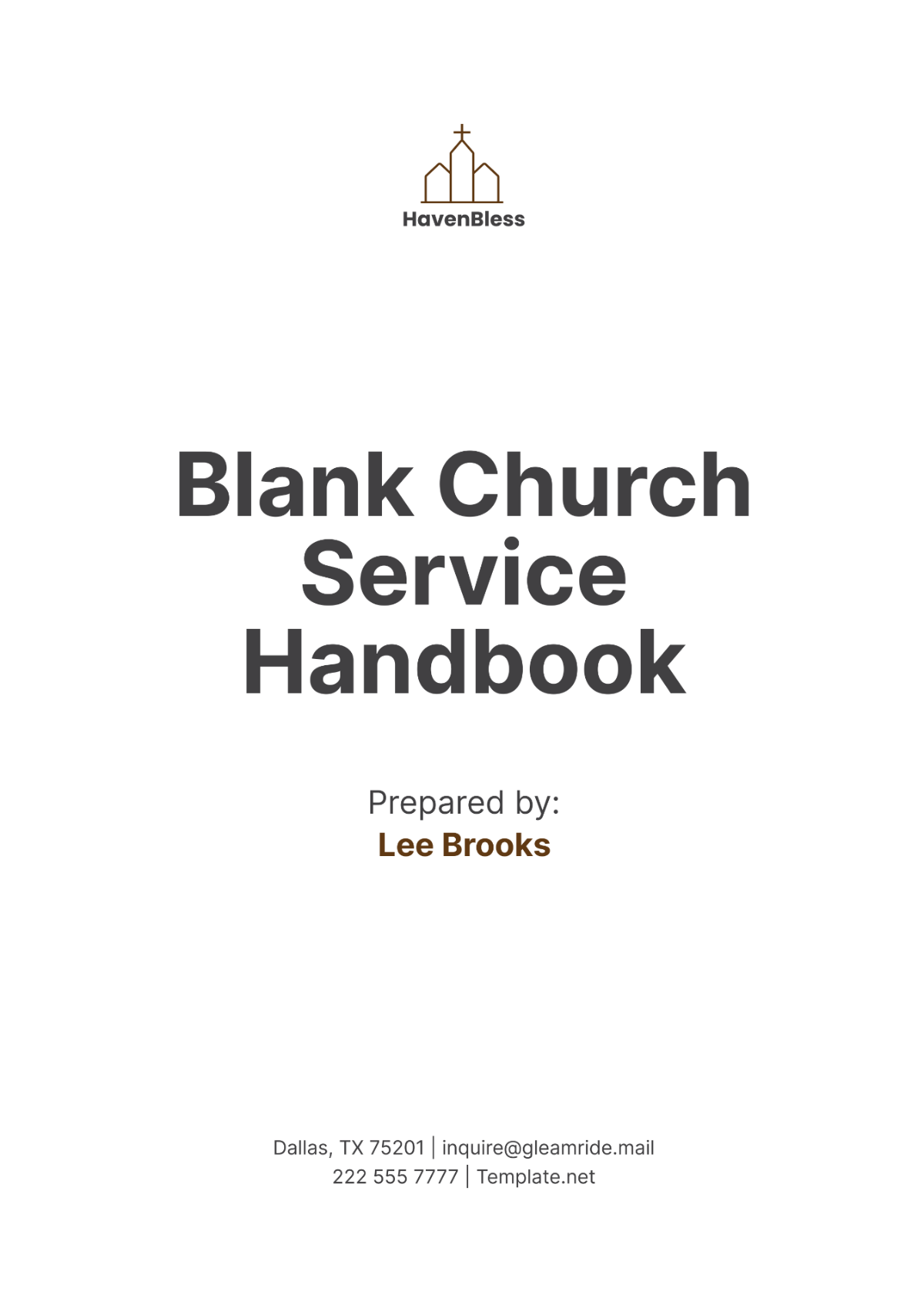Free Blank Church Service Handbook

I. Introduction
A. Purpose of the Handbook
(Describe the overall purpose of the handbook. Include also its targeted audience, and how it should be used.)
B. Contents Overview
(Provide a summary list of the sections included in the handbook. Briefly describe what each section covers to give readers an idea of what to expect.)
II. Service Planning
A. Outline of the Service
(Describe how to structure a church service. Include necessary components like prayers, hymns, sermons, and special announcements.)
B. Choosing Music
(Discuss the process of selecting hymns or worship songs, considering themes, congregational participation, and musical arrangements. Offer guidelines for choosing music that aligns with the day's message and encourages engagement.)
C. Preparing the Sermon
(Provide steps for preparing a meaningful sermon, including biblical study, connecting with the congregation, and delivering the message. Offer tips for staying relevant and impactful.)
III. Pre-Service Preparation
A. Rehearsals
(Explain the importance of rehearsing with the choir, musicians, and any participants in readings or performances. Provide a schedule template and rehearsal tips.)
B. Setting Up the Venue
(Provide detailed instructions for setting up the church. Include seating arrangements, sound checks, and decorations.)
C. Communicating with Participants
(Describe how to communicate effectively with volunteers, musicians, and speakers to ensure everyone is prepared. Include sample communications templates.)
IV. Conducting the Service
A. Opening Procedures
(Detail how to start the service. Include opening prayers, welcoming the congregation, and introducing key elements of the service.)
B. Main Service Segments
(Outline each segment of the service in detail, from the readings to the sermon, including timings and transitions.)
C. Closing Procedures
(Explain how to conclude the service with closing prayers, benedictions, and any final announcements. Provide steps to leave the congregation with a lasting impression.)
V. Special Services
A. Holiday Services
(Offer guidance on planning services for significant holidays like Christmas and Easter, incorporating special themes and traditions. Include sample schedules and activities.)
B. Baptisms and Weddings
(Discuss the procedures and special considerations for baptism and wedding ceremonies. Provide samples for the order of service and necessary forms.)
C. Funerals and Memorials
(Detail how to manage services for funerals and memorials, respecting the grief and needs of the families involved. Offer sample eulogies and order of service templates.)
VI. Volunteer Coordination
A. Recruitment and Training
(Explain how to recruit and train volunteers for various roles within the church, such as ushers, greeters, and technicians. Provide tips for effective training sessions.)
B. Scheduling Volunteers
(Offer strategies for scheduling volunteers in a way that spreads responsibilities evenly and prevents burnout.)
C. Recognition and Retention
(Discuss methods for recognizing and retaining volunteers, such as appreciation events or regular acknowledgments during services. Highlight the importance of making volunteers feel valued.)
VII. Technical Aspects
A. Sound and Lighting
(Provide guidance on setting up and managing sound and lighting systems, ensuring everyone can hear and see clearly. Include troubleshooting tips and regular maintenance schedules.)
B. Projection and Media
(Explain how to use projection systems for displaying lyrics, scriptures, and videos during the service. Include steps for preparing media in advance and backup plans.)
C. Live Streaming and Recording
(Offer instructions for live streaming services and recording them for later viewing. Provide tips for high-quality production and engaging online audiences.)
VIII. Congregational Engagement
A. Encouraging Participation
(Discuss ways to encourage congregational participation, from responsive readings to congregational songs. Highlight the importance of making the service interactive.)
B. Feedback and Improvement
(Explain methods for collecting feedback from the congregation and using it to improve future services. Provide a sample feedback form in the following table.)
Question | Response |
|---|---|
[How did you feel about the music selection?] | [Very Satisfied] |
C. Community Activities
(Outline additional community activities and events that can help engage the congregation outside of regular services. Include examples such as Bible study groups or outreach programs.)
IX. Safety and Security
A. Emergency Procedures
(Provide a plan for handling emergencies, including medical issues, fire evacuations, and other unexpected events. Ensure all leaders and volunteers are aware of these procedures.)
B. Child Safety
(Discuss protocols for ensuring the safety of children during services and other church activities. Include procedures for background checks on volunteers and safe check-in/check-out systems.)
C. Building Security
(Explain measures to keep the church building secure, including locking up after services, monitoring entrances, and using security cameras if necessary.)
X. Appendices
A. Sample Service Scripts
(Provide examples of full service scripts, including prayers, hymns, and sermon outlines.)
B. Contact Lists
(Include a contact list of key personnel, including staff, volunteers, and emergency contacts.)
Name | Role | Contact Info |
|---|---|---|
[John Turner] | [Pastor] | [john@email.com] |
C. Additional Resources
(Provide a list of additional resources, such as books, websites, and organizations that offer further guidance on church service planning and execution.)
- 100% Customizable, free editor
- Access 1 Million+ Templates, photo’s & graphics
- Download or share as a template
- Click and replace photos, graphics, text, backgrounds
- Resize, crop, AI write & more
- Access advanced editor
Provide clear guidelines for church service with the standardized Blank Church Service Handbook Template! This editable template from Template.net is highly customizable to suit your church’s service protocols. The integrated AI Editor Tool aids in creating a detailed and user-friendly handbook, ensuring that all service procedures are well-documented and accessible!





























